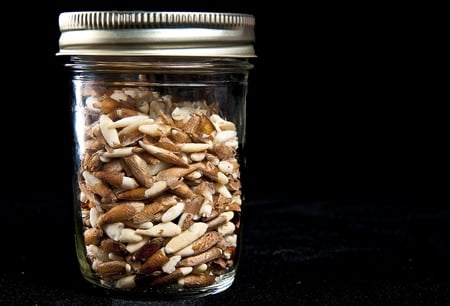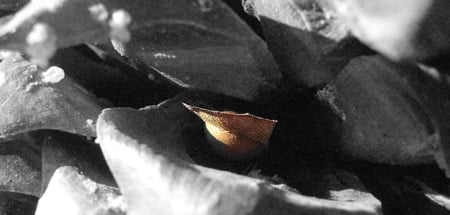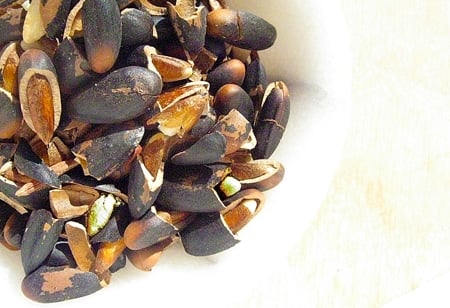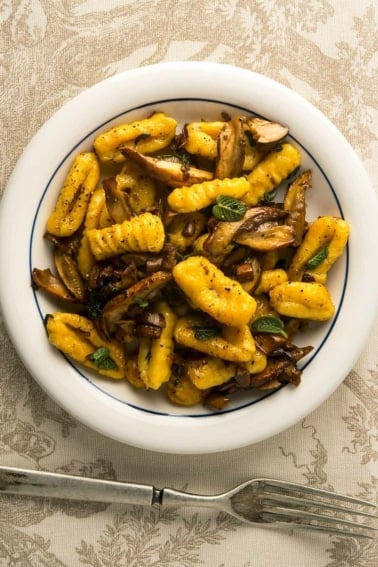As an Amazon Associate I earn from qualifying purchases.

When my friend Charlie asked if I wanted some pine nuts, I said sure, but I was confused. We are a long way from the high desert home of the piñon pine. Uh, where on earth did you get them? “From around my house,” he said. “They’re all over. I’ll bring you a gunnysack full of ’em.” And so he did.
Charlie wasn’t entirely sure what sort of pine he’d been collecting nuts from for years, but he thought — correctly — that they were digger pines. Pinus sabiniana, a tree now called the gray or bull pine because, apparently, the term “digger” wasn’t real complimentary to the local Indians who once used these trees for pitch and for food.
Gray pines are unmistakable: Huge, spare, almost wispy, sporting gigantic cones that can knock you out or even kill you if you are so unfortunate as to be underneath one when it falls. This cone is nearly the size of a toddler’s head. Those are the nuts behind the cone. Aren’t they cute?

Gray pines only live in California, and only inland. They ring the Central Valley and extend a little into Oregon. But you won’t find them on the Coast, or in any other state. They are NorCal’s answer to the great piñon pines of the desert. Oh, and for all of you on the East Coast? Sorry man, but so far as I know there are no pines east the Mississippi that have large enough nuts to be worth collecting. If I am wrong, let me know.
I have ventured to the Great Basin to collect America’s finest pine nuts, those of the piñon pine (Pinus edulis) and the single-leaf piñon (Pinus monophylla). Both are trees of the desert, and are common from eastern California, Nevada and Utah to the Southwest states of Arizona and New Mexico. Keep in mind that more than 90 percent of the pine nuts eaten in American are actually from China and are from for Korean pine.
If you are lucky enough to get your hands on real American piñon or Italian pine nuts (Pinus pinea), treasure them: They are high in fat and will not give you that nasty, metallic “pine mouth” that some Asian pine nuts will. Pine mouth can last for days.

Back to my NorCal pine nuts. You may notice that they don’t look like typical pine nuts. Gray pine nuts are long and slender, although they can weigh almost as much as a store-bought nut. So, you ask yourself, why isn’t someone commercially harvesting the nuts from Pinus sabiniana?
Let me tell you why. To get this little half-pint jar of nuts, it required at least 2 hours of tedious work. It starts with the cones. You collect the cones in September or October and keep them in a place that is airy, but dry; my garage was an ideal spot. You collect the cones when they are still tightly closed — otherwise the squirrels will eat all the nuts before you can get to them. Over time, they slowly open, revealing the nut within.

Your first labor is to get all the nuts out of the cones. Do this by banging them around in the gunnysack (old coffee sacks are ideal) until the nuts all fall out. Or you can whack them on your garage floor. Or you can pick them out by hand. Watch out for the resinous pitch, though, won’t come off your hands unless you douse them in oil or some other solvent.
Many of the nuts will have a little wingy thing attached. This connects the nut to the cone. Toss it. You’ll notice that the nuts range from big to small, and from shiny brown to matte charcoal-black. My experience is that the darker the nut is on the outside, the better the nut is inside. Toss nuts with holes in them; some bug has gotten to it before you.
These are the nuts you are looking for:

That does not mean you should toss all the brown nuts, however, but once you crack them you will find you’ll get a larger percentage of aborted nuts with the lighter-colored nuts. What’s an aborted nut? Apparently, when a gray pine is stressed by heat — this happens mostly at lower elevations — the tree will abort many of its nuts. You can’t tell which are good and which are back until you crack them, but this is what the aborted nut looks like:

To crack a pine nut, you will need vise grips. This is a main reason why gray pine nuts are not sold commercially. The shell is thick, and very, very hard. You can crack the “good” piñon pine nuts of the desert between your teeth, and some innovative souls in Nevada have designed shellers for them. These will not work with the gray pine nut, which has a shell only marginally softer than the dreaded black walnut.
But the vise grips make short work of them. The shells are not circular in cross-section, they are ovals. You crack them along the thin part of the oval, setting the grips at the right spot to just barely crack the shell. You get the hang of it quickly. I can crack nuts reasonably fast this way, but it’s still work. If you don’t have vise grips, use a hammer. I found the best way to open a gray pine nut without pulverizing it was a tap-TAP! with the hammer. All you want to do is crack the shell.

Once cracked, you now need to extract the nuts from all those shells. It’s not as hard as fishing out the goodies from black walnuts, but pine nuts are soft and break easily. The paper skins come right off once the nuts are out of the shell. And those that don’t come off when you toast your pine nuts in a hot frying pan.
What keeps you going with this process is flavor. My friend Charlie insisted that gray pine nuts were better tasting than store-bought. He’s right. Better texture, bigger pine nut flavor. Only the Italian pine nut tastes better, to my palate. Each little nut you free from its shell becomes a gold nugget: Pesto? A cream sauce for pasta? Muffins? A crust for meat? Cookies?
MORE ON PINE NUTS
- Gifts of the Pine, a pasta recipe using pine nuts and other piney things…
- My recipe for Pine Nut Ice Cream.
- My recipe for Pine Nut Crusted Trout




ok, so now I’ve been blessed with some very coveted pinon pinecones, the nuts are now extracted and hammered……what now, do you just refridge or freeze or how do you store them? thanks so much for all your valuable information!!!
Thanks so much for the very valuable information. I love to forage for all kinds of foods. This was very informational, and now I understand why pine nuts are so expensive in the store. I will be looking for some of the trees mentioned on this page, hopefully some of them have been planted here. In any case this has been a great read! Thanks for sharing it!
Hank
Great post. You had info I was looking. My family started gathering pine nuts
last year. We use them for traditional necklaces. Thank you
Sunchowder: Unless you can find where someone planted Italian stone pines, you are out of luck. No native pines with large enough nuts in the East.
Mamajack: Heh. I hear ya. I am astonished at how easily the squirrels get into the cones.
Steve: No way to know until you try!
Stephen: Fry bread with pine nut flour? Oh man, a heart attack on a plate, but oh-so good!
Andy G: Ew.
Matt: Good point. Lots of people have planted those in the East….
Daniel: Sounds like I need to get on that trail with a sack and a shotgun.
The Chumash used to take the “path of the pinon gatherers” to Mt. Pinos which is located in the Los Padres National Forest in Ventura/Kern County. Pinon pine abounds there. I have been taking the path myself over the past few years. A truly magical place and a truly tasty nut!
Good chukar and quail hunting nearby as well.
For those of us in the North/East/Northeast, there are several options for edible pine nuts.
In slightly warmer climes (Zones 7-9) the Italian Stone Pine can be grown. The hardier Korean Stone Pine and Siberian Stone Pine can be grown farther north.
Burnt Ridge Nursery and One Green World are both excellent places to find these trees. Happy munching!
Try coating your hands with vaseline before handling pine cones. The pitch comes off much easier.
Great post Hank. Growing up in NE Nevada, havesting pinon pine nuts was an annual affair. Some years were better than others just like any other crop. We also used the gunny sack beat on the ground separation technique. Then pliers. I now live in AZ and up in the north there are huge swaths of pinon pine. Or I should say that there USED to be. Boring pine beetles have decimated the stands of pinon pine. Same thing up into northern NM. I have often wondered if a similar catastrophic dying out of pinon pines led to the sudden disappearance of the Anasazi, or “Ancient Ones.” They inhabited the area generally located around the Four Corners area. Pine nuts would have been a primary source of nourishment. Especially winter stores. If the pinon pines died en masse, so too would have other food sources. Squirrels for example, which indigenous people hunted extensively using deadfall traps and probably snares. I have also personally witnessed mule deer pawing at pinon pine cones and munching on the nuts, so that food source would have been diminished as well. Just a theory, but a good mystery begs a causation hypothesis. Suddenly I’m thinking of a version of Navajo fry bread with pine nut flour. Hmm. 🙂
Hank,
I have access to Nob Cone pines in Napa. Would they be acceptable?
Steve
I would try anything with a “cookie” label on it…hippie or not! 🙂
Ouch ouch ouch. Hurt fingers. We collected pinenuts for dinner while at Wilbur Hot Springs – probably Digger Pines. And my wife’s family used to collect them in Nevada City. But i really respect squirrels a hell of a lot more, now.
I loved this post. I don’ t know why the thought of foraging excites me so much. Sort of like a treasure hunt I guess. We have lots of pines here in Florida, I am now wondering if I shouldn’t collect some pine cones myself…..:)
Great post Hank, makes one feel humbled. It is is easy to just go buy these tiny source of deliciousness. It is amazing how much labor it requires to process them.
The Brazilian pinhão is delicious. It never occurred to me but next time I am in Brazil I will try making pesto out of it. The nuts are so gigantic I think you would need just a few of them to prepare the dish.
Araucaria trees are incredibly beautiful.
Heguiberto
Nicole: I’ve read about the Coulter pines. I do know the nuts are large enough to harvest from them, but again, it’ll be like these gray pine nuts. Better than the Chinese nuts, but not as good as the desert nuts.
Melissa and Carol: Yep, I know you can find pinons in that area, but from where I live it is closer to drive to Nevada north of Reno.
Joao: Very cool! I’d vaguely heard about these nuts. Thanks for the info!
Melissa (Comment #2) is right about Pinon pines in the Antelope Valley. My family had a vacation cabin in the Tehachapi mountains, and as kids, my brothers and I spent many hours harvesting pine nuts. Last fall, while driving home from a camping trip in California’s Eastern Sierras, my husband and I stopped at a gas station on a Native American reservation, and there were small bags of locally-foraged, unshelled pine nuts for sale. I bought one and spent a good part of the drive shelling and eating them–the taste really took me back to childhood.
Thank you for satisfying my curiosity. I have heard of people collecting seeds from Digger (Grey) Pines and heard it was more work than it was worth. You have convinced me to spend my time in other ways. But….I have also hear of Sugar Pine cone seeds being collected. I live in the Sierras where Sugar Pines are very common. Might have to give that a try.
We got something similar in Brazil.
The araucaria is a Brazilian native tree and is commonly
called the Brazilian Pine Tree. It has always been at the base of the food
system of the inhabitants of the meridional area of the Country. The tree
can reach up to 40 meters of height, and live on average 200 to 300
years, even 500 years.
The pine nut is the Araucaria angustifolia seed, which is approximately
4 centimeters long, ivory colored, surrounded by a thick shell, and picked
in large pines, which can contain from 10 to 120 pine nuts.
In traditional cooking, pine nuts are used in many recipes; they are usually
cooked in water for a number of preparations, or baked directly on the
grill of cooking stoves at the houses of those who picked them. The two
most traditional recipes made with pine nuts are the pine nut paçoca
(cooked and ground pine nut, mixed with dry meat in a pounder), and
entrevero (vegetable and meat stew with pine nuts).
We live on the east coast, and have no viable pine nuts in our area, but my husband came home from a road trip out west with a few nut-laden cones — don’t know the species, and the nuts were just barely big enough to prevent the enterprise of extracting them from being laughable.
I nevertheless concluded that the time, resin-coated hands, and aborted nut ratio, made it just not worth it. And I love pine nuts — which makes me think I’d *really* love those cookies.
I think you can find pinon pines in the high desert in So Cal around the Antelope Valley. Specifically the Tehachapi area. I took a bunch of archaeology classes several years ago out there and my professor talked a lot about the pinon nuts that the Native Americans harvested around the AV. Might be worth a trip next time you are near Los Angeles.
When I lived in Idyllwild California we had Coulter Pines which were nicknamed Widow Makers. I remember hearing the cones falling from the trees and running for safety!
Until I read this piece I honestly never thought about where Pine Nuts came from. Now I understand why they cost so much!